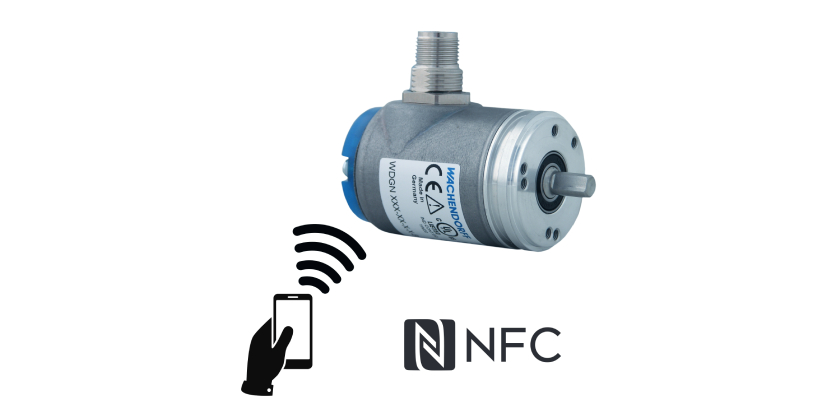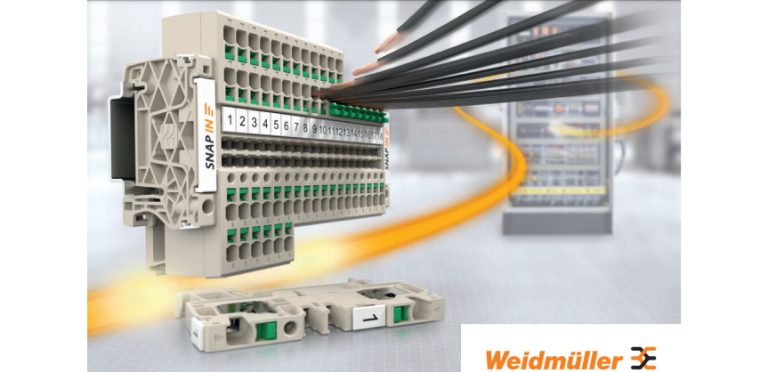NFC as Configuration Interface Instead of Cables and Adapter Boxes – Simple and Smart
June 9, 2023

NFC technology has been successfully adapted for harsh industrial conditions
NFC as Configuration Interface Instead of Cables and Adapter Boxes – Simple and Smart. During the development of a machine, there comes a time when the individual sensors need to be fine-tuned. Uncertainty often arises about the number of pulses required for optimum application. Effort and frustration are therefore inevitable. Choosing the right adaptors, tools and parameterization boxes for sensor adjustment usually doesn’t go as smoothly as expected. The problems continue when the required cable is unavailable.
Without the right cable, the set configuration can’t be changed or adapted. To facilitate this development phase, Wachendorff Automation GmbH & Co.KG has developed an intelligent and simple solution. Instead of relying on the usual adapter cables and parameterization boxes, the company decided to use NFC – Near Field Communication – as the configuration interface when developing the new incremental encoder.
Wachendorff is a medium-sized, owner-managed company with headquarters in Geisenheim near Frankfurt am Main, Germany. The company, which specializes in the development and production of encoders “Made in Germany”, has developed the world’s first incremental encoder that can be individually configured using a smartphone. The individual characteristics can be created and saved to a smartphone application. These settings can now be uploaded to the encoder via NFC. NFC is a powerless and contactless transmission technology. The WDGN series has been equipped with an NFC chip to transfer this established communication technology to the encoder.
A reliable and high pulse rate is generated by the specially developed encoder sensor technology. At the same time, it is so flexible that any pulse rate down to one pulse per revolution can be set. The devices are based on patented magnetic sensor technology with high accuracy and resolution. Highly accurate measurements can be realized in a small installation space with up to 16384 pulses per revolution and a compact design starting from 36 mm.
The flexible parameter setting via the app allows the customer to configure the device on site by himself. This provides greater flexibility in machine development and commissioning. Different controllers or frequency converters can be tested variably. The exchange of the devices on the machine is possible in a very flexible way. This reduces storage and transport costs as less stock is required. Incorrect ordering is reduced to a minimum. Different encoder configurations can be stored directly in the application.
The generic software, specially developed by Wachendorff, can be used regardless of the sensor type. Functionality can be adapted to other sensor and actuator systems, such as enabling features or exchanging data.
The Flutter software, which is compatible with both Apple and Android, was used as the basis for the app’s technology.
NFC technology has been successfully adapted for harsh industrial conditions. The encoder series, with typical diameters of 36 mm and 58 mm, consists of shaft encoders and hollow shaft encoders. Depending on the product type, a shaft load of up to 300N is possible. Reverse polarity and short-circuit protection are provided for the full voltage range from DC 4.75V to DC 32V. All common industry mounting options are available. The encoders can be supplied with an M12 connector or cable outlet, in both radial and axial versions.
The robust stainless-steel housing provides IP67 and IP69K protection, depending on type, and IP65 or up to IP67 at the shaft input. High resistance to vibration and shock is available, as well as an operating temperature range of -40°C to 85°C, making them well suited to use in very harsh industrial environments. The new alloy used for the cover provides better shielding against magnetic influences and makes production even more environmentally friendly.
Data transmission security is also guaranteed. Configuration of the encoder is only possible with the correct password. The communication of the encoder is encrypted, and the different levels of access rights are protected by PINs for the end user. There are several memories in the encoder. The current configuration is stored in the microcontroller’s internal memory and in the NFC memory.
If the values are valid, the configuration in the NFC memory can be overwritten with the desired one and will be transferred to the internal memory after a power reset. If the data in the NFC memory is invalid, it is reset to the last valid values in the internal memory. By using the NFC memory, configuration data can be read and sent even when the device is switched off. This is essential for easy and secure deployment. All data is protected and encrypted by the PIN, even when the device is switched off.
Compared to Bluetooth and WLAN, NFC has a shorter range and communicates in the near field. The longer range of WLAN and Bluetooth makes them more susceptible to interference and potentially easier to attack. Both are active radio standards where transmission can only take place when power is applied. With NFC, parameter configuration can be performed directly on the machine, ensuring limited access. As the NFC module communicates passively, there is no interference during operation. NFC allows wireless and voltage-free parameterization directly on the machine, making it safer and less complicated to use.
The antenna design has been tested with several functional prototypes. For further testing and optimization, several antenna designs were created and procured in production quantities. These were tested for reception quality, distance between smartphone and antenna, and robustness of communication. The best possible ratio between range and space requirement of the antenna was identified.
The solution developed provides sufficient memory for current requirements and sufficient reserves for future expansion. The antenna layout has been optimized to fit on a 20mm x 17mm circuit board while still providing reliable transmission over the maximum distance.
This board is connected to the sensor board via a ribbon cable and special locking connectors. This locking is necessary for high mechanical robustness.
The WDGN is an optimal and simple alternative for customers where the otherwise widely used IO-Link communication standard is not suitable.
The newly developed WDGN series is available in two versions. The Basic version has the standard channels of an incremental encoder (A, B, N) and the inverted channels. The Advanced version is more advanced. Here, four channels can be configured independently.
The new technology easily saves costs and time and increases sustainability.
“The aim of our WDGN series is to offer our customers new options for their encoder configuration,” says Robert Wachendorff.




